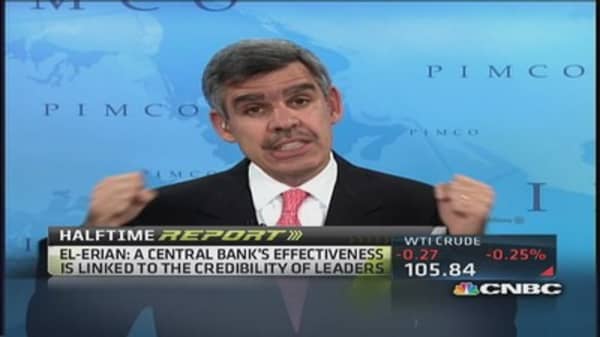"A much-less-certain investment outlook is ahead, and one that requires change not only in what investors do, but also in how they think about their overall investment positioning," he added.
(Read more: Investors don't know what to do about rising rates)
Global central banks, and in particular the U.S. Federal Reserve, are contemplating how to exit the policies used to address the various problems brought on by the subprime mortgage market collapse that triggered the financial crisis and the Great Recession.
El-Erian and his colleagues at Pimco have been particularly vocal lately about how the Fed proceeds from here, encouraging an approach that unwinds the zero-interest-rate-policy, or ZIRP, and the $85 billion a month bond-buying program known as quantitative easing.
Indeed, some have questioned the firm's motives.
But El-Erian said it's important for investors to understand what is happening:
On the surface, the new normal appeared as an unsatisfactory low-level equilibrium. It also triggered, however, an inherently unbalanced policy response in the West; and its international reconciliation was slowed by outmoded approaches to global governance.
In the process, the new normal has morphed into something that is less stable. In some cases, it is now a forced normal. In others, it has evolved fully into a fake normal.
(Read more: Ignore the red herrings—here's the real risk)
As for investing advice and words of warning, El-Erian broke it into seven bullet points:
- Break from the "central-bank wave that will prove more unstable and less effective."
- Look for opportunities that capitalize on "costs and risks" of central bank policies, particularly in emerging markets.
- Asset class correlations likely will start breaking down.
- Get "more cautious" on expectations for risk-adjusted returns.
- Risk management will get more complicated and evolve from mere diversification to the use of instruments that hedge against unusual events, or "tail risk."
- "Given that the world is changing ... guard against falling hostage to outdated benchmarks, guidelines and investment labels."
- Stop relying on "old comfort zones" and prepare to get creative.
If what El-Erian said comes to pass, the primary directive from the past four years of "you can't fight the Fed" likely will fade.
He's the latest of several market experts to stress the importance of fundamentals—a challenge considering the softening economy and decided downward drift during the latter part of second-quarter earnings season.
(Read more: Get ready for a 'massive interest rate shock' soon)
"Up to now, the best investor response to the new normal was to downplay the fundamentals and ride the enormous wave of central bank liquidity," El-Erian said. "Look for the effectiveness of this theme to be increasingly challenged as the new normal morphs into a stable disequilibrium. Artificial asset prices will need to be supported by more than what will be increasingly ineffective central-bank policies."
—By CNBC's Jeff Cox. Follow him @JeffCoxCNBCcom on Twitter.





